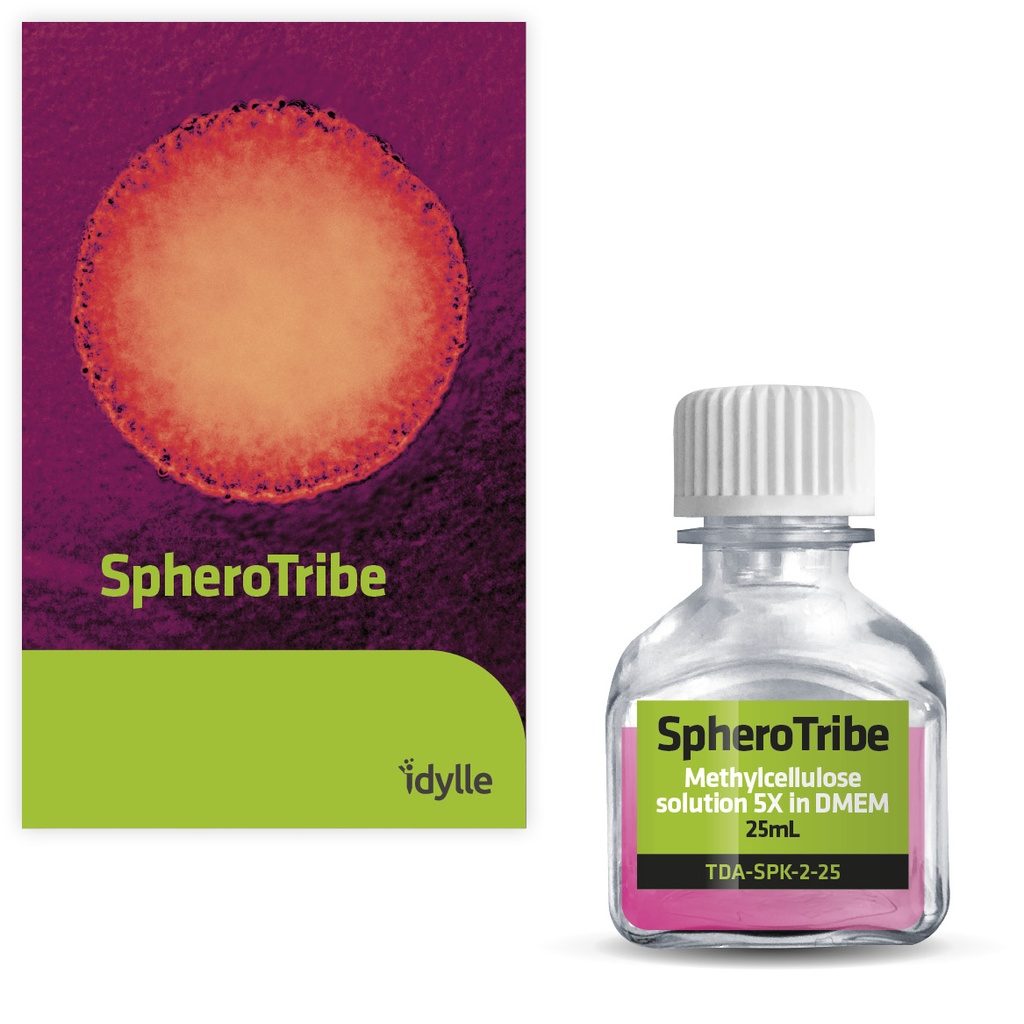SpheroTribe
Catalogue Number: TDA-SPK-2-25-IDY
| Manufacturer: | Idylle Labs |
| Shelf Life: | 6 months |
| Type: | Cell Culture Reagents |
| Shipping Condition: | Blue Ice |
| Storage Condition: | 2-8°C |
| Unit(s): | 1 bottle |
Description
Description: 1 x 25 ml bottle of Methylcellulose
How does SpheroTribe work?
SpheroTribe relies on the use of methylcellulose, a crowding agent that is well-known to drive efficient cell aggregation into spheroids. Once diluted in culture medium, methylcellulose increases the viscosity of the medium, creating a gel-like environment that restrict cell movement and encourages cell-cell contacts for the formation of compact spheroids.
Can SpheroTribe affect my cell physiology or subsequent assays?
The SpheroTribe solution is composed of methylcellulose, a derivative of cellulose that is known to be biologically-inert, i.e. to neither actively contribute to biological responses or interfere with it. It is notably used in various biofabrication tools, including bioinks. In addition, SpheroTribe allows you to culture cells without exogenous ECM components, avoiding the known bias they may have on cell signaling. If needed, SpheroTribe can be readily washed off at any stage of the protocol to leave spheroids available for subsequent assays.
Which cells has SpheroTribe been used with?
So far, SpheroTribe has been successfully used to generate spheroids/organoids with the following cell types:
Patient-derived stem-like glioblastoma cells (GB P3, BL13, T033 & T042), human glioblastoma cell lines (U87 & T98G), HeLa, human vaginal mucosal melanoma (HMV-II), human primary colorectal cancer cells, human breast cancer cells (MDA-MB 231), human colon cancer cells (HT-29), monkey kidney fibroblast-like cell line (COS-7), primary neurons from rat embryos (E18) & murine melanoma cells (B16F10), human induced pluripotent stem cells (hiPSCs)-derived organoids.
Is there a particular medium I need to use SpheroTribe with?
The SpheroTribe concentrated solution is made up in basal medium and does not contain any proteins, lipids or growth factors. You can dilute it in any culture medium of your choice, and add other compounds as desired (i.e. serum, antibiotics, etc).
How many experiments can I perform with one SpheroTribe kit?
One SpheroTribe kit contains everything you need to grow up to 960 unique spheroids. Total number of spheroids generated with one kit may vary depending on the concentration of SpheroTribe solution used for cell aggregation, total spheroid growth duration and frequency of medium renewal.
How long will it take to grow spheroids with SpheroTribe?
The total time to initiate 3D cell culture with SpheroTribe should take no more than 30 minutes. After that, optimal culture duration to achieve desired spheroid size will vary depending on your cell proliferation rate and targeted application. As a general rule, compact & homogeneous spheroids are usually formed after 3 days of culture.
How many cells should I seed in each well?
Optimal seeding density can vary greatly depending on the cell type, proliferation rate and targeted application. You will most probably need to start with a couple of optimization tests to find out which density will best suit your needs. As a general rule, we recommend using 10,000 to 20,000 cells per well for primary cells and 2,000 to 7,000 cells per well for tumoral/immortalized cell lines.
How can I make sure my spheroids will be unique and uniform ?
The SpheroTribe kit has been shown to generate unique & uniform spheroids with most cell types tested. Yet, when working with particularly challenging cells, here are a few tips to keep in mind to maximize your chance to obtain unique & uniform spheroids in each well:
Starting from a single-cell suspension: the presence of cell clumps in your initial cell suspension at the time of seeding can compromise the obtention of unique & uniform spheroids. When starting from isolated primary cells, we recommend that you carefully dissociate cells using filters or columns if needed.
Pre-heating the SpheroTribe solution at 37°C before use: lower temperatures will make it more viscous, potentially favorising the formation of multiple cell aggregates.
If the above advice are not sufficient, centrifuging the plate at 300g for 3 minutes can help with spheroid formation.
Additional Text
Short Description
The all-in-one kit for 3D cell culture
